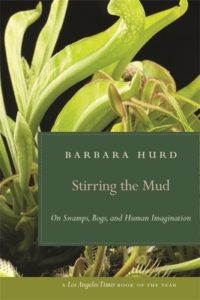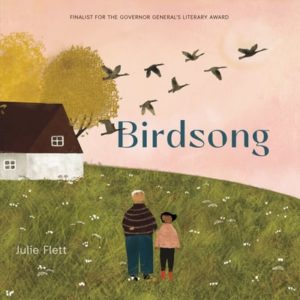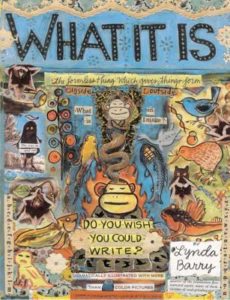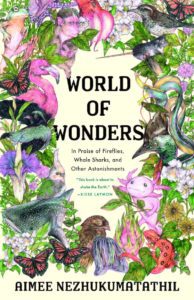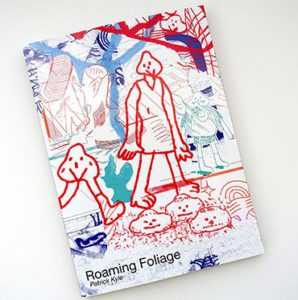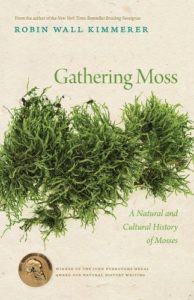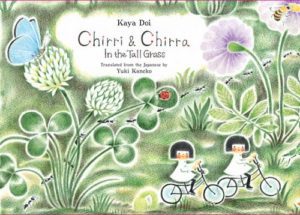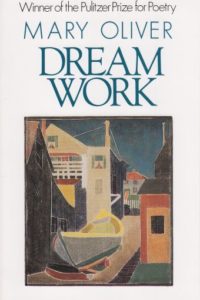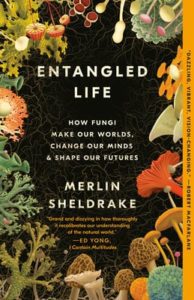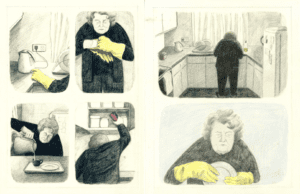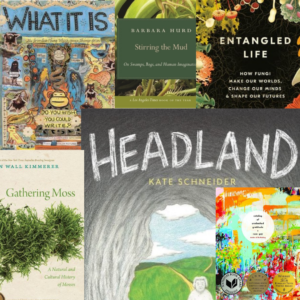
I wrote my graphic novel Headland over many years. It shrank and grew; it changed with me. During months of grief, when I felt my own outline getting blurry, my book became a doorway to the part of myself that I recognized. It was a long project and the reward was making it.
When I am a raw nerve of emotion, nature shows up in symbols and metaphor for me. I think that’s because I am so ripe for meaning-making in those moments. Everything is fodder for a poem, even in my pain I feel so connected and in dialogue with the whole world. It is fascinating to now learn some of the neuroscience of grief, that language is suppressed but sensory images are highly active.
Some landscapes have a magical significance—they catch the eye and invite us to look longer. Carpets of moss that slope down to the water’s edge. Flat stones in a row. Tree hollows, downed logs, ferns that cast blue shadows. These nooks and crannies are the portals to my childhood and back to a deep core self.
There is pleasure in being seen and there is pleasure in disappearing. Wade in to the swamp, pull out a book, wipe off the slime and sit on the edge to become invisible.
***
Stirring the Mud by Barbara Hurd
In these nine essays, Barbara Hurd meditates on the liminal, wading ankle-deep through the world of swamps, marshes, wetlands, bogs, and their slippery edges. Moving deftly between memoir, philosophy, and nature writing, with a curiosity that is contagious, Hurd asks questions of shifting identity and the nature of desire. She takes us through the brackish waters of our own imagination, stirring the mud and seeing what comes up.
Birdsong by Julie Flett
A young Cree girl moves to a small town and feels lonely. She makes friends with the neighbor, an older woman who shares her love of art. As the seasons change her elderly friend’s health declines and the girl makes art to share with her. This simple picture book spans from Spring to Spring, sharing lessons on grief, nature and rebirth.
What It Is by Lynda Barry
Lynda Barry writes: “We don’t create a fantasy world to escape reality, we create it to be able to stay.” We make the world more tolerable, whatever this means for us. She is so generous with her work, it feels less like it is trying to teach us something and more like it’s trying to hand us the space and the confidence to say what we need to. In this lushly illustrated memoir, full of collage and recurring symbols, Barry asks us to dream and to conjure our own magic.
World of Wonders by Aimee Nezhukumatathil
Aimee Nezhukumatathil’s awe for the whole world shines through in this debut work of non-fiction. In her essays, she writes about axolotls, peacocks, and narwhals, weaving in stories from her childhood and parenthood. It’s a delight that reads like a love letter to her family.
Roaming Foliage by Patrick Kyle
Unlike any graphic novel I have read, this story by Patrick Kyle teeters on the brink of falling apart without ever actually doing so. Two plant-boys, a girl without a body, a humanoid robot, and a pumpkin make their way through the wilderness. It is in a constant state of unravelling and has lessons for us if we are paying attention, one of them being that our reality is unstable.
Gathering Moss by Robin Wall Kimmerer
Before Robin Wall Kimmerer wrote Braiding Sweetgrass, she wrote this book on moss. In this mixture of the personal and scientific, Kimmerer writes beautifully on what moss has to teach us, extending beyond the edges of their own biology. She writes that “finding the words is another step in learning to see,” and explores all the ways that language functions as a deeper portal into seeing the forest.
Chirri and Chirra by Kaya Doi
I want to eat this series of children’s books by Kaya Doi. Leaf juice, violet tea, acorn coffee, carrot buns with lemon jam, frozen flower bud marbles . . . This book is so in touch with the way kids see the world. There are animal friends to guide them on their bicycle rides through different climates and landscapes. No grown ups; no problems.
Catalogue of Unabashed Gratitude by Ross Gay
In Ross Gay’s fifth book of poetry, he captures the erotic energy of The Reach. He reaches up for trees, distilling that space that vibrates between the outstretched hand and the fig. He writes, “there is a fig tree taller than you in Indiana / it will make you gasp. / It might make you want to stay alive even.” Thank you, it does.
Dreamwork by Mary Oliver
I treasure this book of poems by Mary Oliver and how it pulls us into her personal space but allows us to also feel so profoundly part of the collective. Here Oliver focuses her gaze on the natural world, showing us what she could lose if she stopped noticing:
Every morning I walk like this around
the pond, thinking: if the doors of my heart
ever close, I am as good as dead.
That is what is at stake for her, and she has taught me so much about how we know who we are by what we pay attention to.
Entangled Life by Merline Sheldrake
When we think of fungus most of us think of mushrooms. Travel down into the fungal network and you will find that the mushroom is just the fruiting body and that nearly every organism depends on in the “Wood Wide Web”. The universe of fungi shatter our concept of the individual, creating a social body and asking us questions that challenge our understanding of our own intelligence, gender, and the boundaries of our belonging.
Kate’s gorgeous book is of course, inspired by all these texts, and we recommend you taking a peek at HEADLAND as well. — Eds.
In Headland, artist Kate Schneider pays tribute to her departed grandmother, presenting with deeply felt empathy a perspective little represented in popular literature. Drawn with soft pencils and lush colors, this graphic novel explores the tensions between safety and autonomy, language and silence, holding on and letting go.

